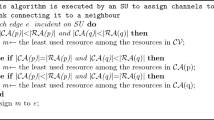Abstract
One of the most challenging issues in cognitive radio (CR) systems is channel sensing and accessing. In this paper, a CR channel access mechanism is proposed. The mechanism consists of two phases: fast channel accessing and proactive channel vacating. In fast channel accessing, a pair of CR users time-efficiently searches an available channel to deliver data. In proactive channel vacating, a pair of CR users periodically makes channel access opportunities to primary users (PUs) and vacates the occupied channel as quick as possible. We utilize the concept of channel hopping to reduce the average channel searching time. Furthermore, our vacating mechanism allows CR users to create opportunities for PUs to claim the spectrum and thus minimize the caused interference to PUs. We evaluate the performance of our approach through a two-dimensional Markov chain model as well as simulations. The performance study indicates that the proposed protocol achieves low channel searching time, high throughput, and fairness.








Similar content being viewed by others
References
FCC Spectrum Policy Task Force. (2002). Report of the spectrum efficiency working group. Federal Communications Commission, Technical Report 02-155.
Sherman, M., Mody, A. N., Martinez, R. & Rodriguez, C. (2008). IEEE standards supporting cognitive radio and networks, dynamic spectrum access, and coexistence. IEEE Communications Magazine, vol. 16, pp. 46–54.
Chowdhury, K. R. & Akyildiz, I. F. (2008). Cognitive wireless mesh networks with dynamic spectrum access. IEEE Journal on Selected Areas in Communication, 26, 168–181.
Niyato, D. & Hossain, E. (2009). Cognitive radio for next-generation wireless networks: An approach to opportunistic channel selection in IEEE 802.11-based Wireless Mesh. IEEE Wireless Communications, 16, 16–54.
Yucek, T. & Arslan, H. (2009). A survey of spectrum sensing algorithms for cognitive radio applications. IEEE Communications Survey and Tutorials, 11, 116–130.
Hsu, A. C.-C., Wei, D. S. L. & Kuo, C.-C. J. (2007). A cognitive mac protocol using statistical channel allocation for wireless ad-hoc networks. In IEEE wireless communications & networking conference, Hong Kong, pp. 105–110.
Kondareddy, Y. R. & Agrawal, P. (2008). Synchronized MAC protocol for multi-hop cognitive radio networks. In IEEE international conference on communications, Beijing, China, pp. 3198–3202.
Le, L. & Hossain, E. (2008). A MAC protocol for opportunistic spectrum access in cognitive radio networks. In IEEE of wireless communications & networking conference, Las Vegas, pp. 1426–1430.
Rashid, M. M., Hossain, Md. J., Hossain, E. & Bhargava, V. K. (2009). Opportunistic spectrum scheduling for multiuser cognitive radio: A queueing analysis. IEEE Transactions on Wireless Communications, 8(10), 5259–5269.
DaSilva, L. A. & Guerreiro, I. (2008). Sequence-based rendezvous for dynamic spectrum access. In IEEE symposium of new frontiers in dynamic spectrum access networks, pp. 1–7.
Jia, J. & Zhang, Q. (2007). Hardware-constrained multi-channel cognitive MAC. In IEEE global communication conference, Washington D. C, pp. 4653–4658.
Su, H. & Zhang, X. (2008). Channel-hopping based single transceiver MAC for cognitive radio networks. In IEEE communication and information systems security, Beijing, China, pp. 197–202.
Mo, J. So, H.-S. W. & Walrand, J. (2008). Comparison of multi-channel MAC protocols. IEEE Transactions on Mobile Computing, 7, 50–65.
Bahl, P., Chandra, R. & Dunagan, J. (2004). SSCH: Slotted seeded channel hopping for capacity improvement in IEEE 802.11 ad hoc wireless networks. In ACM SIGMOBILE, Philadelphia, USA, pp. 315–329.
So, J. & Vaidya, N. (2004). Multi-channel MAC for ad hoc networks: Handling multi-channel hidden terminals using a single transceiver. In ACM international symposium on mobile ad hoc networking and computing, Toyko, Japan, pp. 222–233.
Cabric, D., Tkachenko, A. & Brodersen, R. W. (2006). Experimental study of spectrum sensing based on energy detection and network cooperation. In ACM international workshop on technology and policy for accessing spectrum, vol. 12.
Haykin, S. (2005). Cognitive radio: Brain-empowered wireless communications. IEEE Journal on Selected Areas in Communication, 23, 201–220.
Lee, W.-Y. & Akyildiz, I. F. (2008). Optimal spectrum sensing framework for cognitive radio networks. IEEE Transactions on Wireless Communications, 7(10), 3845–3857.
Jiang, H., Lai, L., Fan, R. & Poor, H. V. (2009). Optimal selection of channel sensing order in cognitive radio. IEEE Transactions on Wireless Communications, 8(1), 297–307.
Jain, R. K., Chiu, D. W. & Hawe, W. R. (1984). A quantitative measure of fairness and discrimination for resource allocation in shared computer system. DEC Technical Report DEC-TR-301.
Author information
Authors and Affiliations
Corresponding author
Rights and permissions
About this article
Cite this article
Chao, HL., Lou, T. & Jiang, S. F2-MAC: an efficient channel sensing and access mechanism for cognitive radio networks. Wireless Netw 17, 1113–1126 (2011). https://doi.org/10.1007/s11276-010-0316-5
Published:
Issue Date:
DOI: https://doi.org/10.1007/s11276-010-0316-5




